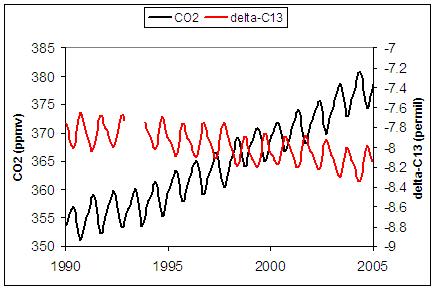dumrick wrote:The people over at Los Alamos really do their best to sell nuclear technology!

In fact, the "carbon-neutral" slogan could be used for a variety of alternative fuel systems, if they relied solely on carbon neutral power on processing. For instance, bio-fuels could be carbon neutral if the power to process the vegetal mass into usable fuel would be, let's say, solar power, wind power or nuclear power (in this case, with the slight inconvenience of a by-product called nuclear waste that needed to be dumped, but nothing a currupt dictatorship in some african country wouldn't accept in the vicinity of some village, in exchange with some land-land missiles, for sure). Or am I looking at this the wrong way?
Well, as my current
understanding of the issues goes, you pretty much hit the nail in the head there. Much of the carbon needs to be taken out of the energy cycle, period. Either that happens by lowering our energy needs, or then we've got to find ways to manage with electricity and hydrogen that is bonded to something else than carbon - preferrably we'll manage both. (
Meanwhile we've also got to be conscious of atmospheric vapor concentrations and greenhouse gases other than CO2 ... Methane has a relatively short atmospheric life, but is 21 times more potent. That's why I'm uneasy about the quantities - and releases - on the kind of industrial scale that meeting gasoline/diesel replacing levels requires.)
I'm not ruling out nuclear as an option, but as the above post implies, the fact is that only a meager handful of all nuclear nations have factored radioactive waste management in the operating costs. Until the rest follow suit, convincingly, I'm not going to be their greatest advocate. Besides, nuclear by definition is highly centralised/high investment, something that doesn't bode too well with economic democracy, personal responsibility and, in a word, empowerment.
Now, I read the "
Green Freedom™" PDF through - once - made some notions, and crunched some numbers to "get my head in the ballpark" about the realistic prospects of nuclear powered potassium carbonate CO2 sequestration and gas liquefication process or whatchamacallit. I guess a disclaimer is in order, namely that none of what follows has been done to any semblance of academic standard and that I only ran any and all numbers once. I trusted my recollection and sources beyond reason. Thus, the propability of mistakes is fairly significant. Nonetheless, I'll try and leave such a trail of "thought breadcrumbs" here that a sort of a "peer review" is possible. I'm more than happy to see any mistakes challenged, my only hope is that any such exercise serves to clarify - and not muddy - the "big picture".
The document states that a sequestration rate of
55kJ/mol CO2 is projected. I'll accept this even though that figure was based on speculative technology and the actual lifecycle analysis of the technology was stated to be incomplete. The other flowchart relating to the energy efficiency (technical, not linked to this thread) just wasn't immediately decipherable. Anyhow, I thought it'd be worthwile to contrast the above figure with current global nuclear capacity and the total "excess" of CO2 in the atmosphere, just for argument's sake.
The
mean mass of atmosphere is around
5,148*10^18 kg, in which the latest measurements indicate a
CO2 concentration of 383 ppm (parts per million), or
0,0383%. This amounts to roughly
3,0*10^15 kg in total; the
pre-industrial baseline of CO2 concentration lies at about
280 ppm or so, which means we have "maxed our CO2 credit" by some 27% to date. That is some
8,1*10^14 kg, or at
44g/mol the equivalent of
1,84*10^16 mol of CO2, a veritable sh*tload of the stuff. Which brings us to balancing our account with the nuclear-potassium-liquefication ... Let's assume that every nuclear powerplant in the World would be retrofitted with this equipment and/or all decommissioned units would be replaced by sequestration plants. We've currently about
440 reactors with a combined output (power) of
366 GW.
By Green Freedom™'s specifications we can then calculate the amount of energy needed to capture the fossil CO2 atmospheric excess, a figure which conveniently comes pretty close to
1,0*10^21 J. And since we have a figure of the
overall nulcear power in our disposal we can project the amount of time it'd take to put the kind of energy through the system as to reduce CO2 from 383 ppm to 280 ppm (or so). If (and it's a big if) I've gotten it even half way right until now, it'd take
~ 31.900 days
or 87 years, and then some. Since these plants come at $5Bn a pop (projected), the hardware cost alone for this imaginary feat could reach $2,2 trillion (that's twelve zeroes in one of them), give or take. Of course there are
quite a few humongous omissions in this kind of logic, so I'll try to explore a few in the most superficial of terms. For starters, the 87 year figure holds up only if we hoarde the resulting carbohydrate fuel and
not use it at all, while remaining
carbon neutral in all other endeavors meanwhile. Otherwise we could extend the process manyfold. And given that we'd be using all nuclear energy in this,
from where we'd find power for the grids anyway?
But this is assuming that the
natural carbon sinks (oceans, forests, etc.) function "as is" meanwhile; we don't know that. Some projections I remember seeing have
solubility, photosynthesis and soil capture reaching a preindustrial atmospheric CO2 equilibrium in 100 to 200 years from the moment we reach closed carbon energy cycles anyway. So I guess, armed with only this superficial information, I'd rather vote for investing that $2.2 trillion in getting rid of carbon in the energy cycles than find elaborate ways to keep churning the stuff around just because we've gotten used to doing so.
Of course I have a few random secondary concerns as well, like the points about infrastructure efficiency holding up, comparing nuclear with high yield solar or geothermal processes for energy sources and so on. I also noted an outward bound arrow marked "methane purge" in the flow chart, which I found worrying; much better to burn the stuff into water and CO2 than release it to the atmosphere. But perhaps that's what it means, I don't know. Also, the carborate scrubbing was said to be very efficient (95%!?) so finding locations suitable for nuclear plant cooling and atmospheric conditions might not be the easiest of tasks ... without very steady air movement the plant risks developing occasional "low CO2" bubbles, perhaps reducing efficiency radically.
I don't know what I'd call this proposal, but "
low risk" and "
transformational" wouldn't spring to my mind as first (or second) options. The scale (resources, time) of the potential project is immense (
just a couple of such plants would hardly make a dent, I was using the entirety of our nuclear energy production as an example for a reason) and I can't help thinking that it'd drain investment from simpler and cheaper ideas - and for all the fanfare, the complete carbon cycle in all this appears murky to me. I'm happy that these technologies are constantly developed, since if we do encounter clear runaway phenomena (exponential, after tipping points) we might require costly desperate measures like engineering weather directly.
But meanwhile, photosynthesis, intellectual diversity and restraint work much better for me.
A couple of links to relevant websites:
Synthetic Fuel Concept to Steal CO2 From Air, Los Alamos National Laboratory
Concurrent Technologies Corporation
Alternative Energy NOW conference, organised by CTC, sponsored by the U.S Air Force etc., I guess that's why they have the Stars and Stripes flying alongside a B-52 bomber on the front page ...
Ps. If you're up to it, read
this blog entry (tamino.wordpress.com). It's about carbon isotopes and how those can be used to tell the source of the carbon in CO2. You guessed it, the fossil sourced carbon isotope shows clearly in the atmospheric balance. Much more raw data on greenhouse gases to be found on the
World Data Centre for Greenhouse Gases (WDCGG).
 Image linked from tamino.wordpress.com
Image linked from tamino.wordpress.com




